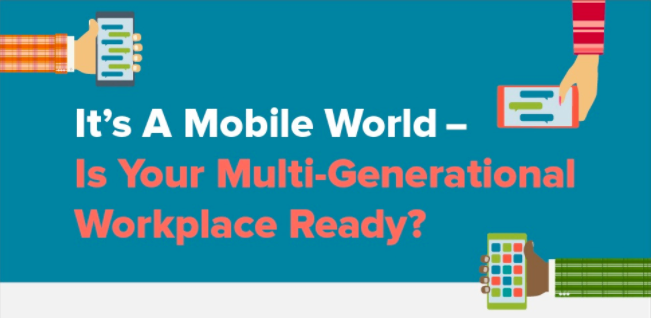
Evolving technology has improved many HR processes over the years. But in a diverse workforce, those employee communication technologies tend to complicate communication efforts. This can slow down the pace and efficiency of keeping employees informed on important and urgent information.
No matter how large or small your team is, communicating with multiple generations can be tricky. Fortunately, employees from every generation agree on the high importance of communication in the workplace. HR pros need to take the next step by re-evaluating both their mobile communication strategy and each generation’s needs.
To help HR pros understand every generation’s mobile communication desires, EmployeeChannel, Inc. dug into the research on the topic and compiled the following research.
Here’s what they found during their look inside the multi-generational workforce:
Everyone wants leaders who communicate.
One thing all generations agree upon is the importance of leaders having great communication skills. A 2016 survey from Randstad and Future Workplace found that both millennials and Gen Z believe communication is the most important leadership quality.
The same is true for baby boomers. In a 2016 report from the International Public Management Association for Human Resources, baby boomers rated “effective communication to keep employees informed” a 4.53 out of 5 on a scale of importance for leadership.
Unfortunately, many organizations do not provide leaders with continuous training to hone these skills. HR professionals assume that once a person reaches a leadership role, they no longer need development. But nothing can be further from the truth.
As communication methods evolve, leaders need continued training in order to keep up. Whenever your team starts using a new communication tool, make sure even the most senior leaders receive full training for it.
Also, collect feedback from employees about their perceptions of their leaders. Ask them what leaders and managers are doing right. But also find out where there’s room for improvement so you can provide the proper training or refresher course.
Don’t assume mobile technology is only a young man’s game
When we think about the typical smartphone user, we imagine a group of millennials sitting together while they all look at their phones. But in reality, the technology has become so pervasive, that nearly everyone has a smartphone.
According to a 2016 Nielsen report, 87 percent of adults over 18 have a smartphone. And many of these people bring their mobile devices to work. However, many employers believe smartphones distract employees.
This is not true when it comes to professional communication. A 2016 report from Sony and Frost & Sullivan found that using smartphones at work increases productivity by 34 percent.
Take advantage of this by using more mobile communication tools. And don’t exclude older employees. A 2016 study from The Economist Intelligence Unit found that older employees find themselves just as productive on mobile technology as younger ones.
Focus on finding communication tools that are easy-to-use. This will ensure that everyone has a great experience and gets the most out of the tool.
Always be reaching to improve
The moment a company feels they’ve mastered communication, they’ve set themselves up for failure. With how quickly communication tech evolves, you always need to be ready to adapt.
Luckily, employees are confident about their ability to keep up with change. A 2016 report from ADP found that 77 percent of employees feel positive about being able to do all their work from a mobile device in the future. They’re ready to take on new challenges.

However, they’re not as sure about their organization’s ability to adapt. The aforementioned The Economist Intelligence Unit study found that 42 percent of employees say their employer is only adequate in their approach to mobile technology.
With employees doubting your ability to stay up-to-date with mobile technology, you have to find ways to reassure them. Start by setting transparent goals regarding communication and mobile tools. This will show everyone that you’re dedicated to change and improvement.
To set these goals, think about why you’re using mobile communication tools. Are you trying to improve productivity? Do you want to increase communication between departments? Are you hoping to keep employees more informed about what’s happening?
Once you’ve established your goals, find metrics that will show how you’re doing. Be sure to share all this with employees. This will help them to understand why new technologies are being implemented and how it will impact their work. Without that information, it will be hard to get them to buy in on new tools.
Communication is the cornerstone of company success. As such, you need to keep up with changing technologies and trends that will help employees interact. But more importantly, you need to understand how different generations are viewing these changes so you can remove assumptions about what they expect. This will allow you to get everyone on the same page and communicating effectively.
What are some other mobile trends affecting how HR communicates in your workplace? Let us know!

